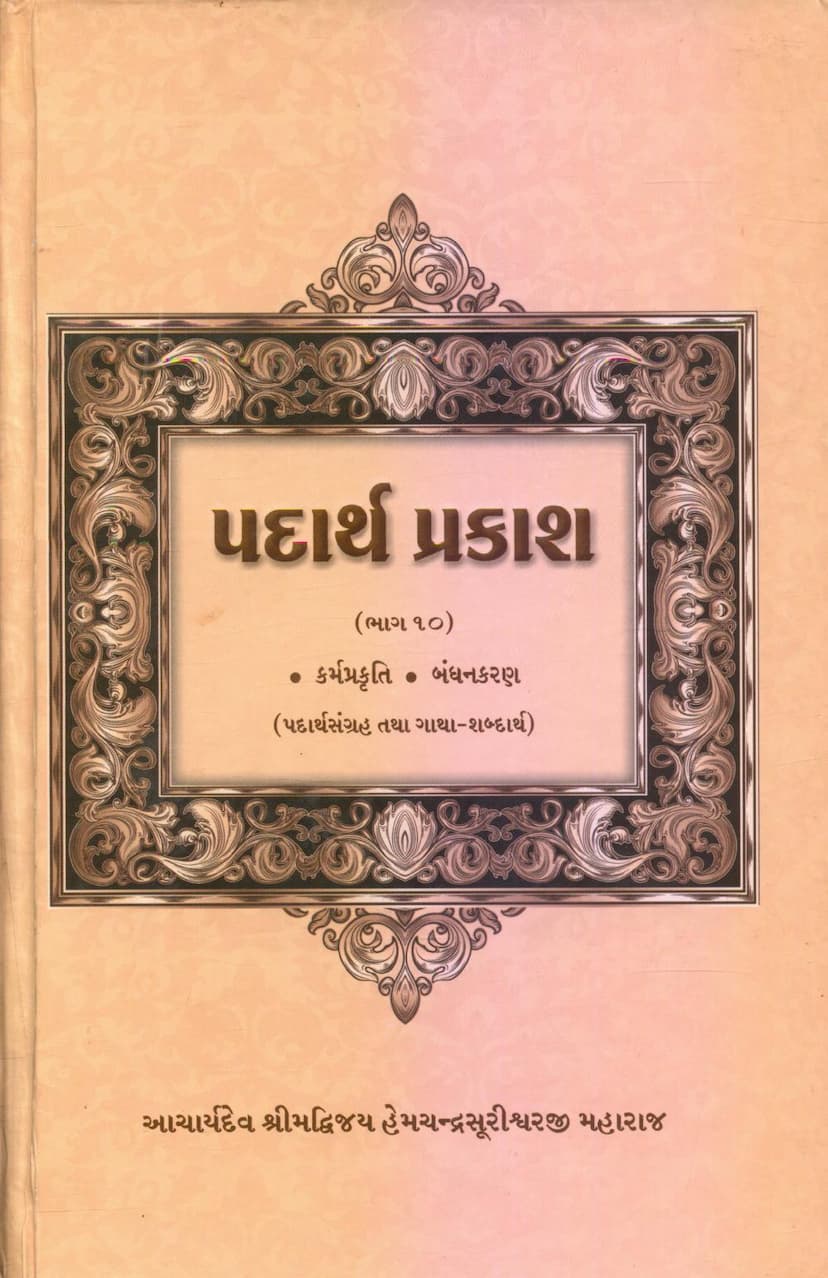Padarth Prakash 10 Karmprakruti Bandhankaran
Added to library: September 2, 2025

Summary
This document is a Jain text titled "Padarth Prakash Bhag 10: Karmaprakruti Bandhankaran" (पदार्थ प्रकाश भाग १०: कर्मप्रकृति बंधनकरण) authored by Acharya Shrimad Vijay Hemchandrasuri (आचार्यदेव श्रीश्रीमद् विजय हेमचन्द्रसूरीश्वरजी महाराज). It is published by Sanghvi Ambalal Ratanchand Jain Dharmik Trust.
The book is dedicated to commemorating the birth centenary of Acharya Shrimad Vijay Bhuvan Bhanusuri and the half-century anniversary of the passing of Gyani Shri Paramavijayji.
Key aspects of the text include:
- Content Focus: The book delves into the "Bandhankaran" (बंधनकरण) aspect of "Karmaprakruti" (कर्मप्रकृति), which is a fundamental concept in Jain philosophy dealing with the types and mechanisms of karmic bondage.
- Purpose: It aims to provide a concise compilation of the "padarthas" (पदार्थों) – the key principles or entities – related to this specific section of the Karmaprakruti, making the profound subject accessible to students and practitioners of Jain scriptures like "Jivavichar," "Navatattva," "Dandak," "Laghu Sangrahani," "Bhashyatrayam," "Chah Karmagranth," and "Brihat Sangrahani."
- Origin of the Text: The text explains that the "Karmaprakruti" itself is an excerpt from the "Agrayani Purva," specifically from the "Prabhrita" within it, compiled by Acharya Shivsharmasuri. It mentions existing commentaries (churṇi and tikas) by various revered Acharyas like Malayamgiri Suri and Yashovijayji.
- Revival of Study: The preface highlights the role of Pujya Premasurishwarji Maharaj in reviving the study of this complex scripture, which had declined over time. He encouraged his disciples and scholars to engage with it, leading to its current widespread study among monks and nuns.
- Author's Background and Inspiration: The preface is written by Acharya Hemchandrasuri, who expresses gratitude to his guru, Acharya Premasurishwarji Maharaj, for the opportunity to compile and publish these principles. He also thanks Pandit Parasbhai Champaklal Shah for research and the printing and design teams.
- Spiritual Goal: The ultimate aim of this publication is to facilitate a deeper understanding and study of karmic principles within the Jain Sangha, leading to the shedding of karma and liberation from worldly suffering.
- Structure: The book follows a detailed index (विषय अनुक्रमणिका) that outlines the numerous topics covered, starting from various classifications of karmic "prakrutis" (like Svanudaybandhi, Swodaybandhi, Ubhaybandhi, etc.) and then moving into detailed discussions on "Dwar" (Dwar - gate or division) related to yogasthanas, pudgalavarganas, sneha, namakarma, kshaya, rasabandha, sthitibandha, and their intricacies.
- Biographical Sketch: A significant portion of the text (pages 12-16) is dedicated to a biographical sketch of the influential Acharya Shrimad Vijay Premasurishwarji Maharaj, highlighting his renunciation, spiritual discipline, scholarly achievements, contributions to Jain literature, and his exemplary life characterized by compassion, humility, and dedication to the Jain faith.
- Detailed Classification: The latter half of the document provides a highly technical and detailed breakdown of various karmic aspects, including:
- Vargas (Categories): Classification of karmic constituents based on their bondage characteristics (e.g., Swodaybandhi, Kramanuvyavachchhidyamana-bandhodaya).
- Dwaras (Divisions): Detailed discussion of 31 "dwaras" related to karmic bondage, covering aspects like gradual increase and decrease of karmic potential, time periods, and the composition of karmic particles.
- Vijnapti (Consciousness/Activity): Explanation of how consciousness interacts with karmic matter.
- Sneha (Adhesion/Stickiness): Detailed analysis of the adhesive properties of karmic matter.
- Namapratyaya and Prayogapratyaya: The role of specific karmic types and their application.
- Bandha Prakarana (Types of Bondage): Discusses Prakruti Bandha (bondage by nature), Sthiti Bandha (bondage by duration), Rasa Bandha (bondage by intensity), and Pradesh Bandha (bondage by quantity).
- Teevrata-Mandata (Intensity-Lethargy): Analysis of the fluctuations in karmic intensity and lethargy.
- Punarvasana (Re-manifestation) and Anukrushti (Consecutive transfer): Concepts related to the continuous flow and transfer of karmic effects.
- Jiva Samudahar (Collection of Souls): The types of souls and their karmic classifications.
- Verse Translations: The text includes the original Sanskrit/Prakrit verses (moolgatha) and their Gujarati word-for-word translations (shabdarth), making the text comprehensible.
In essence, "Padarth Prakash Bhag 10: Karmaprakruti Bandhankaran" is a scholarly and comprehensive Jain text that meticulously explains the complex doctrine of karmic bondage, drawing upon foundational Jain scriptures and offering detailed classifications and explanations for deeper spiritual understanding and practice. It serves as a testament to the rich philosophical and scientific inquiry within Jainism.